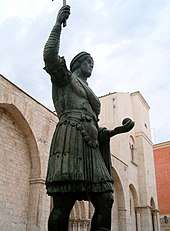University of Constantinople
The Imperial University of Constantinople, sometimes known as the University of the Palace Hall of Magnaura (Greek: Πανδιδακτήριον τῆς Μαγναύρας), was an Eastern Roman educational institution that could trace its corporate origins to 425 AD, when the emperor Theodosius II founded the Pandidakterion (Byzantine Greek: Πανδιδακτήριον).[1]
The Pandidakterion was refounded in 1046[2] by Constantine IX Monomachos who created the Departments of Law (Διδασκαλεῖον τῶν Νόμων) and Philosophy (Γυμνάσιον).[3]
At the time various economic schools, colleges, polytechnics, libraries and fine arts academies also operated in the city of Constantinople.
History

Byzantine society on the whole was an educated one. Primary education was widely available, sometimes even at village level and uniquely in that era for both sexes. Female participation in culture was high. Scholarship was fostered not only in Constantinople but also in institutions operated in such major cities as Antioch and Alexandria.[4]
The original school was founded in 425 by Emperor Theodosius II with 31 chairs for law, philosophy, medicine, arithmetic, geometry, astronomy, music, rhetoric and other subjects, 15 to Latin and 16 to Greek. The university existed until the 15th century.[5]
The main content of higher education for most students was rhetoric, philosophy and law with the aim of producing competent, learned personnel to staff the bureaucratic postings of state and church. In this sense the university was the secular equivalent of the Theological Schools. The university maintained an active philosophical tradition of Platonism and Aristotelianism, with the former being the longest unbroken Platonic school, running for close to two millennia until the 15th century.
The School of Magnaura was founded in the 9th century but did not last very long,[6] and in the 11th new schools of philosophy and law were established at the Capitol School. The period of decline began with the Latin conquest of 1204 although the university survived as a non-secular institution under Church management until the Fall of Constantinople in 1453, and was re-established by Mehmet II as a Madrasa (an Islamic theological school) following the conquest of the city.
Matthaios Kamariotis, lecturer of the University, became the first director of Phanar Greek Orthodox College, which was established in 1454.
Status
A few scholars have gone so far as calling the Pandidakterion the first "university" in the world, but this view does not take into account that the Byzantine centers of higher learning generally lacked the corporative structure of the medieval universities of Western Europe which were the first to use the Latin term universitas for the corporations of students and masters that came to define the institutional character of the university thereafter.[7][8] Nonetheless, the Dictionnaire encyclopédique du Moyen Âge tentatively identifies the Pandidakterion of 425 AD as a "university institution".[8]
See also
- Byzantine Aristotelianism
- Byzantine university
- Faculty and alumni of the University of Constantinople
References
- "The Formation of the Hellenic Christian Mind" by Demetrios Constantelos, ISBN 0-89241-588-6: "The fifth century marked a definite turning point in Byzantine higher education. Theodosios ΙΙ founded in 425 a major university with 31 chairs for law, philosophy, medicine, arithmetic, geometry, astronomy, music, rhetoric and other subjects. Fifteen chairs were assigned to Latin and 16 to Greek. The university was reorganized by Michael III (842–867) and flourished down to the fourteenth century".
- John H. Rosser, Historical Dictionary of Byzantium, Scarecrow Press, 2001, p. xxx.
- Aleksandr Petrovich Kazhdan, Annabel Jane Wharton, Change in Byzantine Culture in the Eleventh and Twelfth Centuries, University of California Press, 1985, p. 122.
- Peter Rietbergen, Europe: A Cultural History, Routledge, 1998, p. 101.
- Myriobiblos
- Markopoulos, Athanasios (2008), "Education", in Jeffreys, Elizabeth; Haldon, John F.; Cormack, Robin (eds.), The Oxford handbook of Byzantine studies, Oxford Handbooks in Classics and Ancient History, Oxford: Oxford University Press, pp. 785–795, ISBN 978-0-19-925246-6
- Robert Browning: "Universities, Byzantine", in: Dictionary of the Middle Ages, Vol. 12, Charles Scribner's Sons, New York, 1989, pp. 300–302 (300):
Universities, Byzantine. The medieval Greek world knew no autonomous and continuing institutions of higher education comparable to the universities of the later Middle Ages in Western Europe.
- Marina Loukaki: "Université. Domaine byzantin", in: Dictionnaire encyclopédique du Moyen Âge, Vol. 2, Éditions du Cerf, Paris, 1997, ISBN 2-204-05866-1, p. 1553:
Le nom "université" désigne au Moyen Âge occidental une organisation corporative des élèves et des maîtres, avec ses fonctions et privilèges, qui cultive un ensemble d'études supérieures. L'existence d'une telle institution est fort contestée pour Byzance. Seule l'école de Constantinople sous Théodose Il peut être prise pour une institution universitaire. Par la loi de 425, l'empereur a établi l'"université de Constantinople", avec 31 professeurs rémunérés par l'État qui jouissaient du monopole des cours publics.
External links
- Spyros Panagopoulos, "Higher Education in Byzantium" (in Greek)